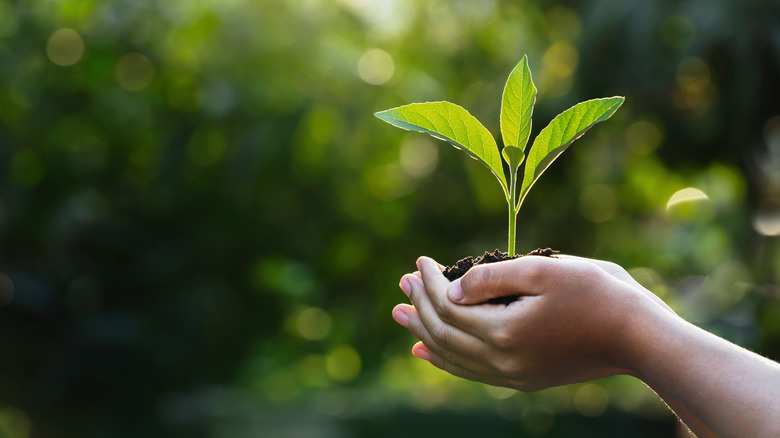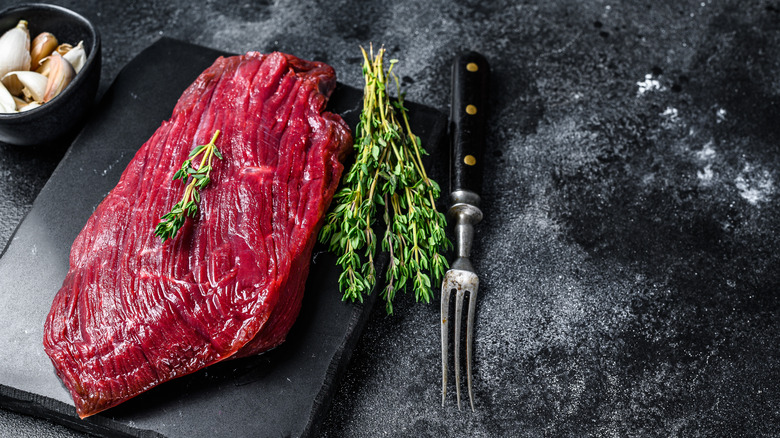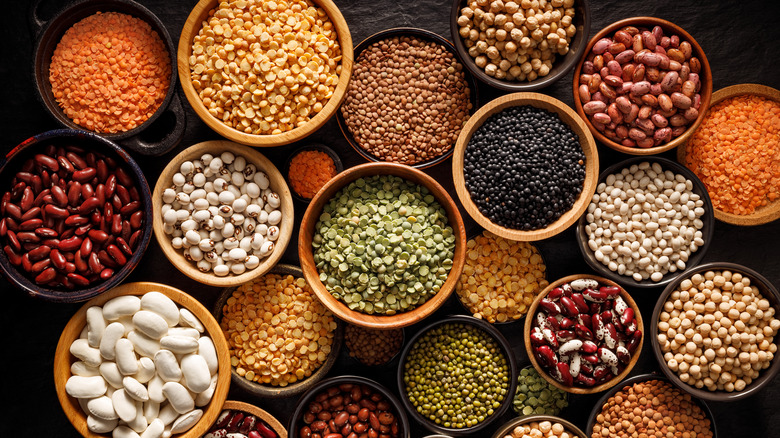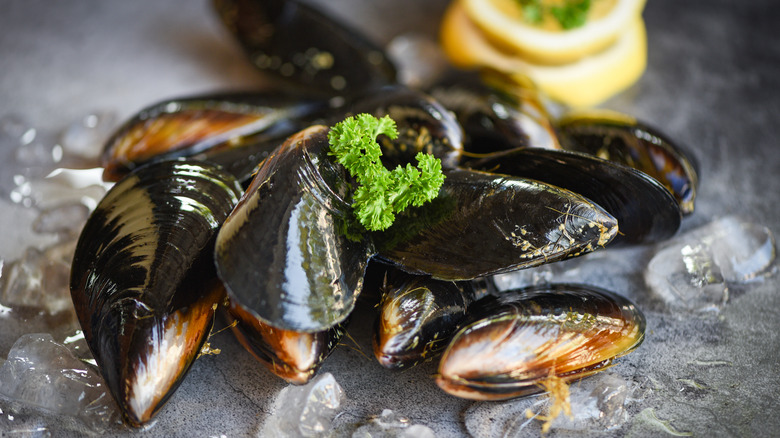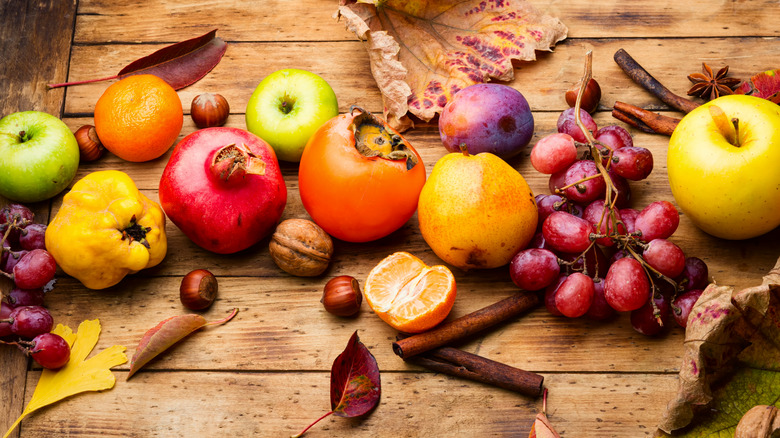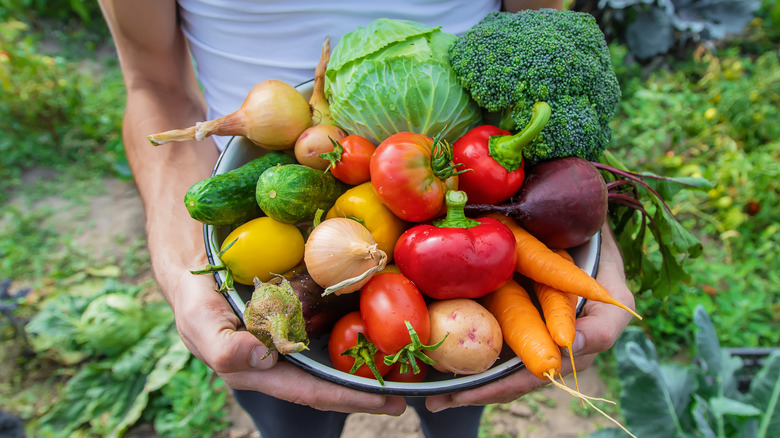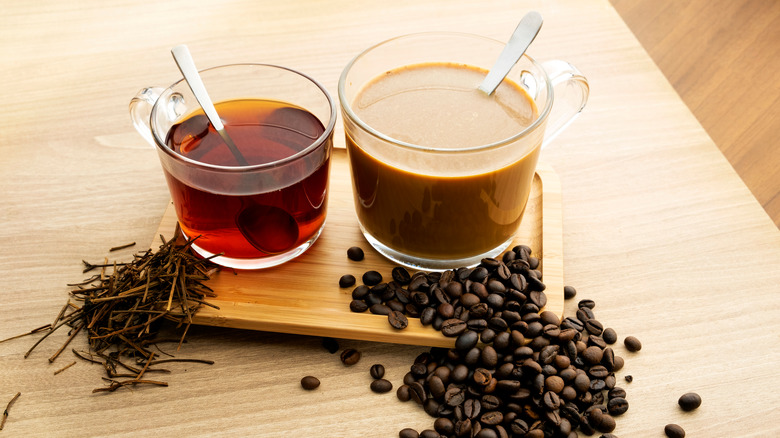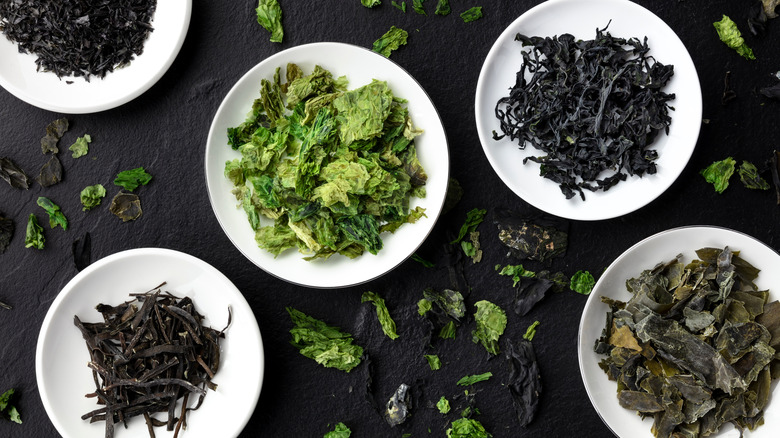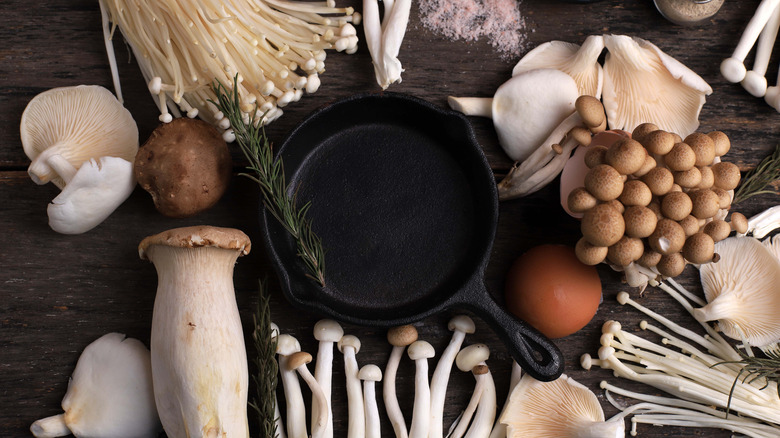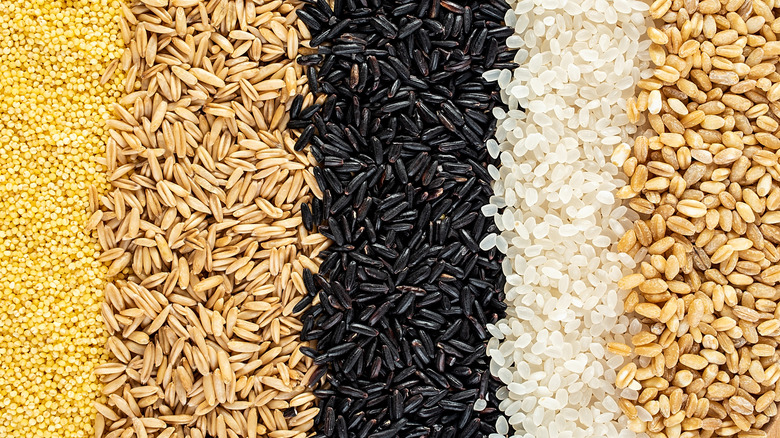The Most Eco-Friendly Foods On The Planet
In order to fully delineate what we mean when we say certain foods are eco-friendly, it's important to clarify the difference between 'eco-friendly' and 'sustainability.' You've likely heard — and used — these terms interchangeably. However, the notable difference is that of absence versus presence. Foods (and other products more generally) are considered eco-friendly when they pose little or no harm to the environment — whether by the means, chemicals and materials through which they are produced, or by virtue of their being biodegradable and/or renewable. Sustainability, on the other hand, aims to actively yield some kind of economic, social and/or environmental benefits. Hence, at their core, eco-friendly products simply allow us to reduce the impact we're already having on the environment. While most things that are sustainable will probably be eco-friendly, not everything eco-friendly is sustainable by default.
For example, the manufacturing of an item might use little energy — making it eco-friendly, but if it's packaged in plastic, it's not sustainable. Unless you're consuming nothing but food you've grown and foraged yourself, some kind of energy will be used to get it to you. This is part of why experts in the field often speak more about sustainability than eco-friendly, and why we are encouraged to be aware of "greenwashing" in how products are marketed to us. Nevertheless, there are foods that, by virtue of how, when, and where they are produced, will be kinder to the environment than most others. Read on to find out what these are.
Venison
Considering that many people are familiar with eating less meat as one of the things they can do to reduce their carbon footprint, why would venison — deer or elk meat — be included as an eco-friendly food? A decade ago, The Guardian reported that venison might be the perfect meat. Although chicken and pork paled in comparison to its flavor, amount of protein per gram and sustainability profile, it appears that even in 2012, venison was still largely considered a meat for the elite. Although its prices at the time were on par with those of other red meats.
More recently, The Washington Post reported that venison could very well be the most eco-friendly and sustainable food you can possibly eat, particularly if you hunt the animal yourself. Attributed to this was a study which found that deer browsing has a significant impact on vegetation, which in turn has a negative impact on other plants and animals. For people, reports have shown that collisions with wild animals (including deer) in certain parts of the United States have accounted for more people being killed than through any other type of animal-involved accident. Deer also emit more methane than cattle per-pound, according to The Washington Post. Which is to say, you might not want to give up meat entirely, but if you're willing to adjust, this could be a worthy culinary avenue to explore.
Lentils, beans and other pulses
Lentils and beans are such an important part of many people's diets across the globe — but what of pulses? If you're not familiar with the term, these are simply the edible bits of your legume plants. According to the Food and Agriculture Organization of the United Nations, there are 11 types of pulses, all harvested exclusively for dry grain which serves as food and feed. Among them are: dry beans, broad beans, peas, cow peas, pigeon peas, chickpeas, lentils, bambara beans, vetches, lupins, and pulses nes.
Pulses are an exceptional alternative source of protein. They boast an impressive micronutrient profile, including zinc, iron, magnesium, and folate, and promote overall gut health, good bacteria and lower levels of toxins and cholesterol (via FAO). Moreover, researchers Caroline Wood and Wayne Martindale, from the University of Sheffield and Sheffield Hallam University, have argued for pulses as an important food to incorporate into eco-friendly efforts. Beyond teaming up with bacteria to fix nitrogen in the atmosphere, they help to maintain fertile soil for continued crop production. They are also water-efficient, and when packaged in cans (which can be recycled), they will have a long shelf-life — and the liquids in which they are preserved can be used as an ingredient in other dishes (via The Restaurant Business). This is certainly worth the countless ways you can incorporate these ingredients into your latest recipe try-outs and everyday favorites.
Mussels, clams and oysters
If you've ever wondered how oysters became so popular, you'll find several citings. Some might reference Thomas Downing, 1800s New York City oyster cellars, and abolition movements. Others might point to the Greek and Roman empires. More recently, their popularity is attributed to 'Hot Girl Summers' and the re-emergence summer (via Refinery29). Hate them or love them, oysters and other shellfish are more than just a delicacy of our time, they also have much to offer toward the well-being of the environment.
According to the BBC, clams, mussels, oysters and scallops are a unique family of sea creatures that not only feed themselves, but when they're rope-grown, they can also create habitats for other creatures. Economically, bivalve farming can stimulate greater gender equality as more women can have more access to work along the coastal areas in which they are located. The BBC's Rachel Lovell said, "This means women can balance earning an income with childcare needs, which is not the case when it comes to offshore fishing." Food52 has also highlighted their carbon efficiency, noting that the carbon cost of bivalves is about the same as that of vegetables, in addition to their filtering and cleaning the water as they grow — long before they're harvested and make it to the dinner table.
Local, seasonal fruits
According to Sustainability For All, there are four distinct benefits to be reaped from sourcing and eating your fruit seasonally. Firstly, because seasonal fruits are less likely to be transported from faraway farms, less energy and carbon dioxide are used and emitted into the atmosphere. Secondly, seasonal eating is in line with nature's own cycles of production and harvest which is more ecologically-sound as nature gets to simply work according to its own rhythms. Another advantage is that fruits that are grown seasonally taste better; they're grown at the ideal time of the year and within the ideal conditions — undisturbed by greenhouse processes. And finally, seasonal fruit is more likely to be sourced from local traders, thus stimulating local economic activity. Altogether, this means that not only are local, seasonal fruits eco-friendly, they are also sustainable.
In light of the above however, a 2014 study illustrated that although seasonal diets generally lead to a consistent supply of fresh produce throughout the year, it is still important to consider the nutritional and environmental benefits in tandem with other modern societal norms and behaviors around food. Which, per The European Food Information Council, means we must also take into account other forms of pollution including what's contributed by land use, fertilizers and water use. As with most other aspects of eco-friendly and sustainable lifestyles, nothing works in isolation, hence seasonal diets are no different.
Local, seasonal vegetables
In addition to well-considered seasonal fruit, perennial vegetables offer another layer to sustainable fresh produce. According to SBS, vegetables like artichokes, asparagus, eggplant, kale, broccoli, and scarlet runner beans can last for a long time when growers are intentional about how they are cultivated and gathered. For instance, scarlet runner beans continue to grow from the same roots, while broccoli and kale can be cut rather than uprooted. Nothing screams eco-friendly quite like produce that allows you to leave the soil undisturbed or that continues to grow even after a first harvest.
If you'd like to take it a step further and source seasonal vegetables from your own garden, there are several things you can do to ensure the process is eco-friendly long before your first harvest. Some of these include creating compost bins, designing vertical gardens for small spaces, upcycling items like basins for herb gardens, growing seeds in recycled household items rather than plastic pots, and collecting rain water (via Pebble Magazine).
Fairtrade coffee and tea
Beside water, tea and coffee are some of the world's most consumed beverages. In 2021, Americans alone sipped on about 3.9 billion gallons of tea, while approximately 70,000 servings are drunk every second across the globe! And that's just tea. Of the estimated 1.6 billion cups of coffee that are consumed daily, there are an estimated 125 million people who rely on this beverage's fair trade as their source of income, according to Fairtrade International.
It cannot be ignored that, in general, the consumption of coffee and tea present somewhat of a dilemma where eco-friendly foods are concerned. Their production has been reported to perpetuate both environmental harm and human rights violations (via The Ecologist and Perfect Daily Grind), making it impossible to separate environmental impact from the social impact of its production on whole communities, and the myriad of issues laden along that pendulum. Of course, first prize would alleviate all issues, but for those who cannot go a day without their cuppa or an alternative, it's worth ensuring that said cuppa is at least ethical. According to Fairtrade International, this acts as a financial safety for smallholders, sets and maintains living wage standards, and helps to create space for the considerations of other salient issues like agricultural practices and conditions.
Fairtrade International also reports that, "When you choose Fairtrade coffee, farmers can build a better quality of life for their families and communities. Your purchase also supports them to invest in growing better quality beans and confronting challenges like the effects of climate change. It's win-win."
Algae, seaweed and kelp
Apart from sushi, seaweed is mostly ascribed to foraging communities and finding creative ways to use this ingredient in everyday recipes like lasagna and salads. But seaweed is part of an even broader, eco-friendly family of greens. Algae, seaweed, and kelp have all been found to be valuable contributors to climate change efforts. While algae broadly refers to the non-flowering aquatic plant that's typically found in both fresh and marine water, it can also include seaweed, with kelp constituting the biggest subgroup of seaweed.
A 2019 study (via Microbial Biotechnology in Agro-Environmental Sustainability) has demonstrated algae's potential as a renewable resource for producing biofuel in a sustainable way. Not only are seaweed and kelp considered superfoods of the ocean, farming them is quite beneficial for the environment. Seaweed acts as a natural filter and fertilizer; it removes toxins from the ocean while also helping farmers to forgo chemical fertilizers that are otherwise harmful to the environment (via Inhabitat). Even with legislative hoops still to jump, in Sweden, researchers continue to advocate for kelp farming as a sustainable source of carbon sequestration.
Mushrooms
Mushrooms are a delicious fungi, but they might be the most sustainable vegetable from the moment they begin growing, right until they are harvested and added to your bowl of pasta. According to the American Mushroom Institute, this is because mushroom agriculture is incredibly water efficient; one pound of mushrooms requires less than 2 gallons of water from growth to harvest, whereas other fresh produce demand up to 50 gallons per pound. Mushrooms' carbon emissions and land use profiles are just as impressive; one pound produces a miniscule 0.7 pounds CO2 equivalent, and yields an estimated 6.55 pounds per single square foot of the bed in which it's grown.
Beyond boasting unmatched sustainability figures and a medicinal nutrient profile, mushrooms have the potential to take over the creation of eco-friendly garments within the fashion space. Per Wallpaper, mycelium — the fine filaments found in the vegetative part of mushrooms — can be used to create a biomaterial akin to leather. This sparked the interests of major clothing labels like Hermès and Kering (the overarching owners of Gucci, Balenciaga and Saint Laurent), among others, to form notable material solutions partnerships that would see them incorporating this material in their creations.
Given the significant negative impact of cattle farming on the environment, this shift to more natural, alternative materials is a major source of relief for the planet.
Whole grains
If you think of all the health advice you've heard — just as you know about the importance of consuming fruits and vegetables on a daily basis — you likely know about choosing whole grains over refined grains. According to Healthline, besides supporting digestive health, whole grains have been associated with lowered risk of heart disease, type 2 diabetes, stroke, cancer, chronic inflammation, and obesity.
In addition to these health benefits, whole grains are able to feed more people with less waste than other foods. For instance, the Whole Grains Council highlighted that, while 197 gallons of water are used to make a single burger patty, only 6.4 gallons of water is used for the bun. And whereas a single bushel of wheat might equate to 42 loaves of refined white bread, it will instead equate to 60 loaves of whole grain bread. Not only are they better for most people who do not suffer from particular illnesses that may otherwise limit whole grain intake, but parting with refined grains is better for the environment too.
